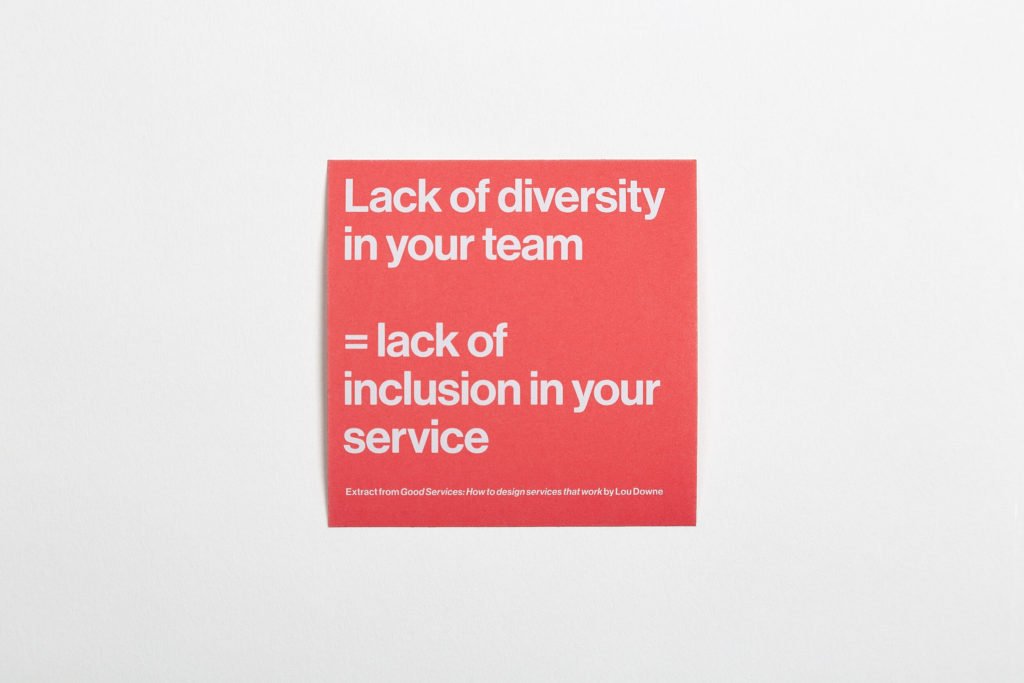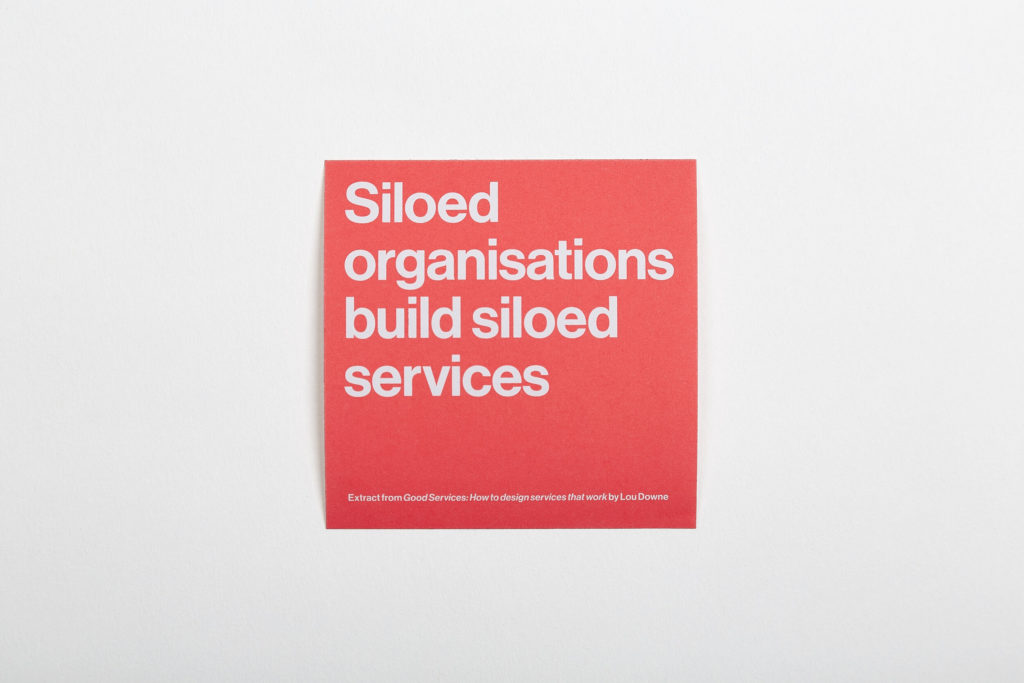Notes
Re: Results as the product of a system
...putting new actors into the same system will not improve the system's performance. What makes a difference is redesigning the system to improve the information, incentives, disincentives, goals, stresses, and constraints that have an effect on specific actors.
Thinking in Systems by Donella H. Meadows (2008)
This echo's Lou Downe mention of Conway's Law in Good Services. The law states that "[a]ny organization that designs a system will produce a design whose structure is a copy of the organization’s communication structure." The product/services/result is "infused with the essence of its creators."1
Downe goes on to say that siloed organizations result in siloed services, and that lack of diversity in your team results in a lack of inclusion in your service. I bought the two stickers seen below, and they sit on my window sill as a reminder.


This all makes me look at the systems we have in place in our society, and it's like, "Duh. Of course we're where we are today." Look at our foundations. The boundaries we've crossed. The lives we've silenced. The voices we've magnified. The kinds of values we've allowed to proliferate.
I can be upset about this, but can also zoom in and recognize how a person's decisions (my 'odd/bad' decisions included) are viewed as rational to them within the network of information they have. It's not an excuse for the (possibly negative) behaviour, but you get a better idea about why the behaviour manifests. It helps quell the anger, so I can switch to something that helps me move on.
Footnotes
1 – Van Dusen, M. (2016, May 19). A principle called “Conway’s Law” reveals a glaring, biased flaw in our technology. Quartz. Retrieved Aug 23, 2020, from https://qz.com/687457/a-principle-called-conways-law-reveals-a-glaring-biased-flaw-in-our-technology/
Highlights & Annotations
Re: non-human/colloquial language for services –
“The reason this happened is simple, and happens every day in the creation of services. The title of the policy, somewhere long ago, had simply been made into the name of the service, without a thought to what language is a user might use.” (49)
“You can't change or alter your user’s goal. But, even if the service you provide is one small part of a much larger journey, or in fact, designed to intercept that end-to-end journey (like a government regulation) it's important what you provide works with all of the other elements of the end-to-end service and user might use to achieve their and gold. Doing this requires awareness and collaboration with people outside of your organization – coordinating data, language and processes so that you are working well for a user.
As our lives become an ever-more-complex web of technology and services, integration of all of the parts needed to achieve a goal into one seamless service is increasingly important to users.” (79)
“But Monzo wasn't too successful because it did something new but because this new thing was easier than what came before....This is what we often called ‘disruption’, but these companies do more than simply disrupt markets, they set user expectations. What Monzo created was an outlier expectation that became Universal.” (88)
- // Kano Model
- Innovation → norm
“Industries that are traditionally hard to negotiate are among the most colonized, with perhaps chief among them being Financial Services.” (97)
“Your users may be first time users, but they will come to your service with a set of assumptions, expectations and even superstitions that will need to be corrected, adjusted or reinforce, depending on their accuracy. This first step towards this will be understand what expectations your users have in the first place. This will mean during user research to find out.
Once you know and understand expectations, there will be some that you need to actively contradict, and those you need to design into your service. Only you can know what these are, but as a general rule of thumb try to consider what expectations are good for your users, your company and society at large. If they aren't, they will need to be something you proactively change.
Alongside navigating your user's expectations of your service on first use, you will need to understand how expectations affect other services across the whole user journey.” (104)
Melvin Conway: “...the structure of an organization has a direct effect on the structure of the services it provides.” (113)
Conway: “Because design that occurs first is almost never the best possible, the prevailing system or concept may need to change. Therefore, flexibility of organization is important to effective design.” (113) → importance of iteration
“We're seeing a new economic model emerging, one where our company buys, or makes use of, another company to provide a whole experience for a user – we can think of this as a kind of experience integration.
Experience integration means that you provide an experience across multiple organizations that is integrated. If another company does this and integrates your service into their own, it can mean that your service or organization needs to take on a very different shape. Switching from being a user-facing service to something altogether more infrastructural, where one service provider provides an end-to-end service out of component parts found elsewhere on the market.” (115)
“Compared to the other areas of service, we generally spend very little time thinking about how many steps of service needs to have and how quickly our user should move through them. This is partly a result of the fact that most services are created from scratch, so we rarely get to question something as fundamental as the number and pace of steps in the service. Instead we see it as a product of accidents and evolution, rather than a conscious choice.” (122)
“A good rule of thumb is to think to yourself – if this thing was done automatically without my knowing about it, would that be a good thing? If the answer is no, then it's best to create a separate step to your service to make sure that your user has full visibility and control over what they're doing. Separate steps in your service also give important moments of transparency on what you as a service provider are doing.” (123)
“But it's not just in sport that the idea of ‘weak links’ explains why things that involve multiple people delivering an outcome either succeeds or fails. The theory was used in economics by Charles Jones to describe why certain developing countries remain less economically successful, despite investment into specific economy boosting Industries like manufacture and roads.” (131)
- // Zilber → learn about the big ideas
- Concepts appear in different forms across disciplines
“Minimum viable product. Minimum viable service.” (137)
“Good services are only as strong as their weakest link” (143)
- // systems thinking
“...when a user is unable to access a service using one technology, we can rely on the other one that came before it to enable the user to reach their own goal. We can see this as a kind of progressive enhancement in reverse, or progressive degeneration of the service.” (153) → graceful degradation
“When thinking about making sure that a service is usable by everyone, we tend to think only about people with physical or cognitive disabilities. But, while making sure that your service is accessible to those of different abilities it's hugely important, there are many reasons why certain groups of people might be more likely to be excluded from your service, which are bigger than the scope of what we commonly referred to as ‘disabilities’.” (160)
“Instead of thinking about designing for 80% of needs that are easily met, we should spend our time with the 20% of the needs that are these so-called outliers to understand how those in the most difficult circumstances can carve a pathway through our services that is easier for everyone to use.” (169)
“You might set out with the best of intentions, but subtle things about the way your service works, was funded, or the way you encourage your staff to do a good job, can all have an impact on whether you reach that goal, for you and your users.” (179)
“...the people who were responsible for this behavior were not just consumers, but the corporations that serve them.” (183)
- // users being the problem vs the corps thinking more ethically about their services → responsibility lying further up the chain

